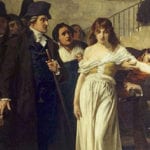 Technology
Technology  Technology
Technology  Humans
Humans 10 Everyday Human Behaviors That Are Actually Survival Instincts
 Animals
Animals 10 Animals That Humiliated and Harmed Historical Leaders
 History
History 10 Most Influential Protests in Modern History
 Creepy
Creepy 10 More Representations of Death from Myth, Legend, and Folktale
 Technology
Technology 10 Scientific Breakthroughs of 2025 That’ll Change Everything
 Our World
Our World 10 Ways Icelandic Culture Makes Other Countries Look Boring
 Misconceptions
Misconceptions 10 Common Misconceptions About the Victorian Era
 Mysteries
Mysteries 10 Strange Unexplained Mysteries of 2025
 Miscellaneous
Miscellaneous 10 of History’s Most Bell-Ringing Finishing Moves
 Technology
Technology Top 10 Everyday Tech Buzzwords That Hide a Darker Past
 Humans
Humans 10 Everyday Human Behaviors That Are Actually Survival Instincts
 Animals
Animals 10 Animals That Humiliated and Harmed Historical Leaders
Who's Behind Listverse?

Jamie Frater
Head Editor
Jamie founded Listverse due to an insatiable desire to share fascinating, obscure, and bizarre facts. He has been a guest speaker on numerous national radio and television stations and is a five time published author.
More About Us History
History 10 Most Influential Protests in Modern History
 Creepy
Creepy 10 More Representations of Death from Myth, Legend, and Folktale
 Technology
Technology 10 Scientific Breakthroughs of 2025 That’ll Change Everything
 Our World
Our World 10 Ways Icelandic Culture Makes Other Countries Look Boring
 Misconceptions
Misconceptions 10 Common Misconceptions About the Victorian Era
 Mysteries
Mysteries 10 Strange Unexplained Mysteries of 2025
 Miscellaneous
Miscellaneous 10 of History’s Most Bell-Ringing Finishing Moves
10 Pop Culture And Historical Events That Started Off As Jokes
Human history is filled with dark, depressing stretches of misery and suffering. It should be treated with reverence and awe. Yet, most of it is hilarious.
Plenty of historical and cultural milestones only began when one joke spun out of control. The lives of millions of people were shaped just because one person wanted to try his hand at comedy. That might be the funniest joke of it all.
10 Teenage Mutant Ninja Turtles Was Meant To Be A One-Off Parody
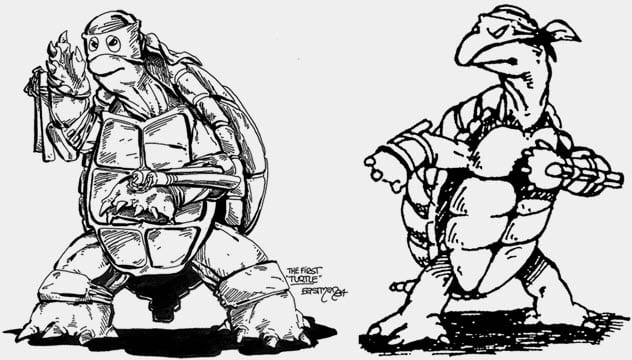
In the early 1980s, Kevin Eastman and Peter Laird were bored. They had met a year earlier in hopes of becoming comic book cartoonists. Nothing was coming to them. While Laird was watching television, Eastman absentmindedly doodled. He drew a humorous sketch of a turtle with nunchucks and a mask. The image was so ridiculous that he showed it to Laird.
Laird thought it was so hilarious that he tried his hand at drawing one himself. The duo kept one-upping each other until they had four distinct vigilante turtles. Upon finishing the first sketches, Laird said, “This is the dumbest thing ever.” That might have been true, but Eastman and Laird wanted to turn the nonsensical idea of sword-wielding reptiles into a real thing.
The first issue of a Ninja Turtles comic book needed a plot as absurd as its characters. They settled on a parody of other popular comics in the early 1980s. It was the laziest parody they could think of.
Each of the titular adjectives of the newly dubbed Teenage Mutant Ninja Turtles coincided with a favorite trait from one of other popular superheroes. The “teenage” described Jack Kirby’s canon. The “mutant” was a nod to the X-Men franchise.
“Ninja” was borrowed from Frank Miller’s samurai series Ronin. But this was not the only Frank Miller property from which Eastman and Laird borrowed. Daredevil gained his powers in the same toxic spill that created the Turtles. As the Daredevil main nemesis was “The Hand,” it only made sense that the Turtles fight the Foot clan.
Eastman invested $1,000 of his uncle’s money into self-publishing this bit. They turned a simple night of goofing around into a 42-page comic. From there, the TMNT franchise of TV series, video games, movies, and toys was born.[1]
9 The Duck That Laid The Golden Egg

In 1983, George Lucas was coming off the heels of one of the most impressive streaks in movie history. He had just made American Graffiti, the Star Wars franchise, and Raiders of the Lost Ark. It looked like he could do no wrong.
But anybody who has been alive for the past three decades knows how much wrong he can do. Given carte blanche to create his vision, Lucas wanted to make a live-action version of one of his favorite comic book characters. For the first time in his career, Lucas stumbled. And what a stumble it was. The resulting movie, Howard the Duck, is now considered one of the worst comedies of all time.
As it was the first feature film adaption of a Marvel story, Lucas was assured that the movie was going to be a huge success. To fulfill his dream, he hired Gloria Katz and Willard Huyck, the screenwriting team with whom he had worked on his big break, American Graffiti.
With the talent and intellectual property, everything looked like it was going to be great. It was not. Infamous scenes of interspecific love, endless duck puns, and rampant sexism led to a commercial and critical flop. In the US, Howard the Duck only earned back $16 million of its $37 million budget.
George Lucas had bet that the box office would fish him out of debt. With lackluster sales, he had to start selling his assets. One of those sales included the computer animation division of his production company.
His friend Steve Jobs bought the project. Jobs turned that investment into Pixar Studios. With movies as diverse as Toy Story, Up, and Finding Nemo, Pixar has produced movies that turned out far better than Howard the Duck.[2]
8 ‘The Ostrich’ Stuck Its Head In The Underground
Lou Reed was the personification of leather-clad coolness. For a generation, he represented the epitome of New York swagger. Reed made his name on freaked-out records about taboos like heroin abuse, sadomasochism, and transsexualism. His best-selling song may have invited listeners to take a “walk on the wild side,” but his origins could not have tamer. One of rock’s great rebels started off as a pure corporate shill.
In the mid ‘60s, Reed was the in-house songwriter for Pickwick Records label. Pickwick was as minor as a record label could be. Without much success on their own, they had to try to fool people into buying their records.
Reed’s job was to write cheap knockoff singles that rode the popularity of fads of the time. When songs about hot rods were big, he invested a lot of mental power on a record called “Hot Rod Song.” “Johnny Can’t Surf No More” was a similarly obvious way to cash in on the surfing crazy.
Reed’s talent for mimicry eventually gave way to gimmicky absurdism. “I’ve Got a Tiger in My Tank” parodied car songs by adding giant cat roars on top. His attempt at a dance craze was the equally ridiculous “The Ostrich.”
This may not be Lou Reed’s best song, but it was certainly one of his most important. To record it, Pickwick hired a young Welsh musician named John Cale. Reed and Cale’s partnership began there. The duo blossomed three years later with The Velvet Underground, one of the most influential groups of all time.[3]
7 The Novelty Record That Launched Gangsta Rap
In the 1980s, the California Raisin Advisory Board began airing a Claymation commercial for raisins. They could not have imagined how popular this was about to become. The basic plot of the commercial is that a man awakens to see a line of Claymation raisins dancing and singing to a parody of the Motown classic “I Heard It Through The Grapevine.”
The incredibly unfunny joke is that raisins come from grapes. Despite the simplicity of the punch line, the commercial became a cultural phenomenon. People could not get enough of the idea of dried fruit covering Marvin Gaye. The California Raisins released toys, a Saturday morning cartoon, a line of video games, and, of course, albums.
This inexplicable success was good news for Priority Records, a small independent LA label that hadn’t had a hit in years. All of a sudden, they were making millions off this silly fad.
Flush with this extra revenue, they could hire more interesting acts. The next artist signed by Priority was N.W.A., the opposite of the California Raisins in a lot of ways.
Weeks later, Priority became a rap powerhouse off the success of Straight Outta Compton. The album and Priority exploded gangsta rap into the public, changing music forever.[4]
6 Susanna Salter Won An Election On A Prank
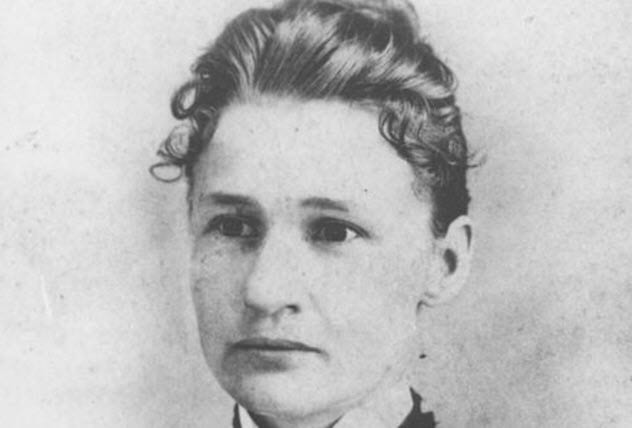
Decades before US women could vote nationally, Susanna Salter had already held public office. In 1887, the tiny Quaker town of Argonia, Kansas, elected the first woman mayor in US history. The election was a turning point in women’s suffrage.
Though she had a rather uneventful administration, Salter’s victory helped usher in a wave of other woman mayors in the West following the Civil War. However, Salter only got her position because a prank backfired.
She was a good choice for a mayoral candidate. Salter had political experience in her blood. Her father, Oliver Kinsey, had been Argonia’s first mayor. Her husband was city clerk.
With her own legal background, she prepared a local attorney for the bar. Salter wrote the ordinances of the town. She presided at the Woman’s Christian Temperance Union (WCTU) caucus. Under her leadership, the caucus selected men deemed worthy of office.
A group of 20 men did not like the idea that a woman had so much say in local politics. They devised a plan. They made a ticket with a set of candidates identical to the ones supported by the WCTU. The only difference is that they substituted Salter’s name in the mayor position. They assumed that no man would vote for a woman.[5]
They also expected that Salter would be embarrassed and leave politics with presumably such few votes. When Salter voted that afternoon, she was shocked to find that she was listed as a candidate. She was even more amazed that she had received a two-thirds majority of the vote.
5 A Sexist Joke Discovered The Cosmos
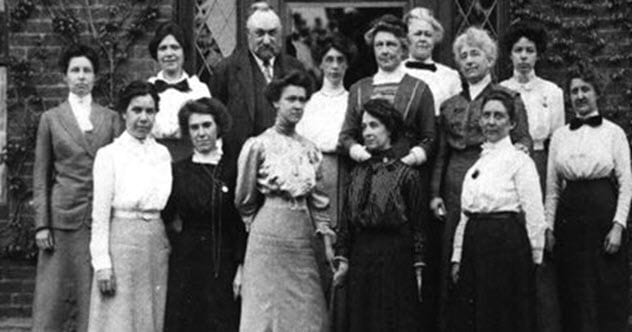
Edward C. Pickering was going over the calculations from his researchers’ latest observations. When the researchers could not understand the calculations, he joked that they were so easy that his “Scotch maid could do better.”
This line may not have been meant as a joke, but it was interpreted as one. Pickering had been aware that his maid, Williamina Paton Stevens Fleming, was a mathematical genius. None of the other male researchers believed that.
The researchers called Pickering’s bluff and brought Fleming in. Very quickly, the researchers became the butt of the joke. Fleming’s calculations were incredibly precise. Impressed by her skill, Pickering started hiring only female researchers. There was also the additional incentive to save money by providing cheaper wages.
No matter the motive, that decision actually changed the universe. These women, known dismissively as “Pickering’s Harem,” conducted groundbreaking research. Fleming finally broke out of Pickering’s shadow when she discovered the Horsehead Nebula.
Other notable members included Annie Jump Cannon, whose system for identifying stars is still applied today, and Henrietta Swan Leavitt, who supplied the data that Edwin Hubble used to measure galactic distances.[6]
4 Wristwatches Started Out As A ‘Silly-Ass Fad’

Businessmen and rappers like to flaunt their latest Rolexes as the height of class. To anybody from the turn of the 20th century, they would look ridiculous. It would be like bragging about bejeweled fidget spinners. Instead of flashy displays of wealth, wristwatches were originally chintzy novelty tricks.
Before wristwatches, men generally kept their watches in their pockets. It was seen as effeminate to wear your watch on your wrist. When men in Europe picked up on it, The New York Times called it a “silly-ass fad” in 1916.
Wristwatches then became popular among vaudeville stars as “more or less of a joke” or a “funmaker.” As far as jokes go, watching a dial spin around a clock is fairly tame. Wristwatches really took off in the US because of something not funny at all—World War I.
It was the first war to feature sophisticated aerial attacks. Soldiers on the ground needed to move as a unit. Timing was essential. When dodging gunfire and bombs, the delay from retrieving one’s watch from a pocket was an actual matter of life and death. To shave off extra seconds, soldiers wrapped their pocket watches to leather straps on their wrists.[7]
Following the war, the soldiers brought this practice home with them. Companies like Cartier began modeling their products from these military designs. No longer a joke, they became an iconic status symbol.
3 A Prank Might Have Killed Vincent Van Gogh
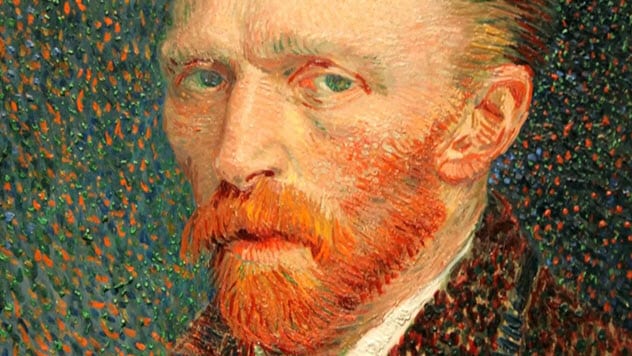
Vincent van Gogh is as famous for his death as his life. His suicide perfectly fits the model of a rejected genius so shunned by the world that he would rather kill himself than go on.
Generations after his untimely death, van Gogh was recognized as a true genius, making his death all the more tragic. This narrative is poetic, but according to Pulitzer Prize–winning researchers Steven Naifeh and Gregory White Smith, it is dead wrong. They are convinced that van Gogh was accidentally shot to death in a joke gone wrong.
Van Gogh had as much success making friends as he did wearing earmuffs. He was often the target of a gang of teenagers who liked to get drunk and mess with him. Van Gogh took particular interest in Gaston Secretan, but it was Gaston’s brother who proved to be the most consequential for van Gogh.
Whereas Gaston was quiet, Rene Secretan was a young prankster. Rene pulled harmless practical jokes on van Gogh—like putting salt in his coffee or hiding a garden snake in his paint box.
Much to van Gogh’s chagrin, Rene also had a habit of waving around a malfunctioning pistol while dressed as the pioneer Buffalo Bill. Naifeh and Smith believe that Rene’s comedy became tragic one fateful night when the gun accidentally went off. The discharged bullet lodged in van Gogh’s abdomen. He died 29 hours later.
The theory has been met with serious backlash from other historians, but there is some evidence to support the claim. Despite his mental anguish, van Gogh did not leave behind a suicide note. In 1956, following the release of the highly acclaimed van Gogh biopic Lust for Life, Rene admitted to torturing the artist.
In 2014, doctors noted that van Gogh would have held the gun in an unnatural and awkward position to shoot the bullet from the angle suggested by the entry wound. This configuration would have caused black powder burns on his hands. At the time, no doctors noted any burns.
Dr. Vincent Di Maio, a leading handgun forensic expert, concluded in 2014: “It is my opinion that, in all medical probability, the wound incurred by van Gogh was not self-inflicted. In other words, he did not shoot himself.”[8]
2 The Butt That Killed Thousands
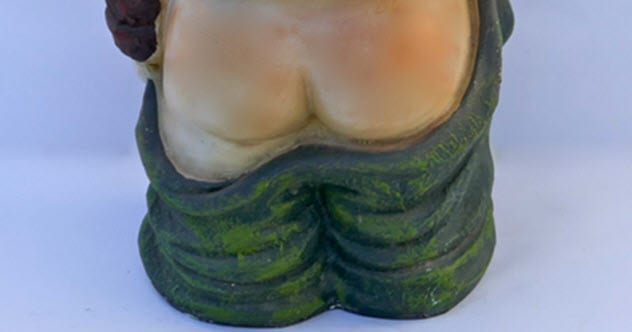
Mooning is asinine, particularly the first syllable. For something so stupid, it sure is a simple joke. Everything one needs to make the joke is already attached to them. Throw in a fart for good measure, and one has reached the pinnacle of bathroom humor. Jewish historian Titus Flavius Josephus recorded how one fart was not silent, but it still was deadly.
AD 66 was not the best time to be devoutly Jewish. The Roman government ostracized the religion and caused deep divides. Tensions were at their highest around religious holidays. One unnamed soldier widened this rift when he exposed a crack of his own.
The mooned Jewish pilgrims did not like being the actual butt of the joke, especially during Passover. The insulted pilgrims threw rocks at the soldiers, who deployed reinforcements. The resulting stampede left more than 10,000 people dead. The riot marked one of the more seismic events in the lead-up to the First Jewish–Roman War.[9]
1 The Party Was Lit At Le Bal Des Ardents
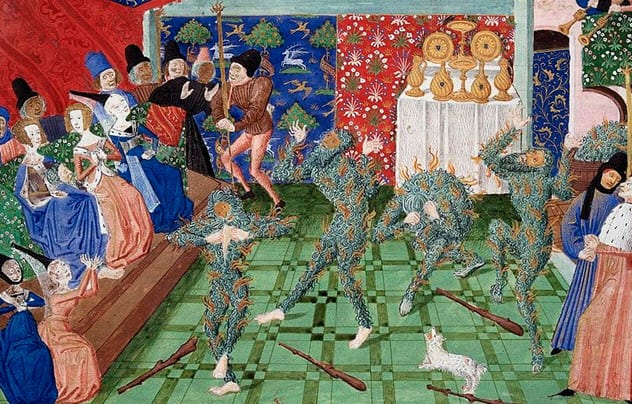
For some historical events, comedy is tragedy plus time. For others, comedy plus time is tragedy. Few events capture that better than Le Bal des Ardents (“The Ball of the Burning Men”).
In the 1300s, third weddings were light affairs where pranks were common. King Charles VI of France thought it would be funny to prank the wedding of his queen’s lady-in-waiting Catherine de Fastaverin. Instead of having a fun time, Charles VI committed the ultimate party faux pas when he ruined the dance floor.
His prank was less a witticism and more a display of stupidity. The joke amounted to having some attendees dress up as wild apes while howling and shouting obscenities. To look like beasts, their costumes were covered in hair consisting of hemp, linen, and tar.[10]
For a short while, their antics were the life of the party. That quickly changed when Charles VI’s brother showed up late and drunk. He stumbled in with a torch in hand. The embers from the torch set the men on fire.
Four of them died as their costumes burned. The heat so scalded their genitals that their testicles fell to the ground. The king barely survived by jumping into his aunt’s skirt.
Charles VI was already mentally unstable, but this event pushed him over the edge. The tragedy also revealed how fragile he was. Concerns about the stability of the throne led to sectarian violence. Charles was now perceived as a failure. His Valois bloodline was seriously defamed, eventually leading to two decades of civil war over the throne.
If you enjoyed the article, you can write to the author at [email protected]. If you want to see what the author thinks is funny, you can follow him on Twitter @NateYungman. Hopefully, his jokes don’t cause any civil wars.
For more historical events that didn’t happen like you think they did, check out 10 Historical Events With Hilarious Forgotten Details and 10 Obscure Historical Events That Would Make Amazing Movies.

